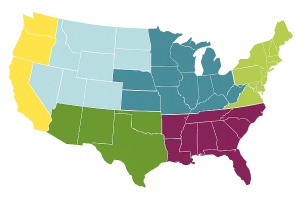Best Wildflowers For Attracting Monarchs to the Garden
Posted By American Meadows Content Team on Feb 9, 2018 · Revised on Oct 3, 2025

Knowing your location helps us recommend plants that will thrive in your climate, based on your Growing Zone.
Posted By American Meadows Content Team on Feb 9, 2018 · Revised on Oct 3, 2025
Entice monarch butterflies to your backyard garden by offering a diversity of wildflowers that bloom at different times throughout the year. Gardeners can support thriving populations of monarchs by pairing nectar plants with appropriate host plants to support the larval development of Monarch caterpillars.
Wildflowers are ideal for attracting monarch butterflies because they are easy to grow and bloom with abandon. Following are the best wildflowers for attracting monarchs all season long.
Read on for the best wildflowers for each season:
Each spring, monarch butterflies leave their warm wintering grounds in Mexico for a long journey northward. The butterflies pass through the southern plains and southeastern states along the way. Unlike fall migrations, where a single generation of adult butterflies completes the full trip, spring monarchs reproduce along the northward trek. The full journey from Mexico to the northern United States and Canada takes several successive generations of monarchs to complete!
Meanwhile, on the west coast, monarch populations that spent the winter in southern California begin their migrations inland and northward. For both populations, migration and reproduction require large amounts of energy which adult monarchs gather in the form of nectar. Planning for early-season blooms is a great way to give these garden beauties a boost in the spring.

While nectar plants are important, milkweed is an essential component of the monarch’s spring resources.
The relationship between the monarch butterfly and its host plant, native milkweed, is well known. Adult monarchs sip nectar from milkweed, and lay their eggs among its leaves. Monarch caterpillars depend upon milkweed plants for survival. One monarch caterpillar can eat over 20 milkweed leaves in its lifetime!
Early-blooming milkweed species provide a place for migrating monarchs to reproduce along the northward journey. Whorled milkweed (A. verticillate) blooms as early as May in southern states and continues to flower all summer. The white blooms stand atop tall stems and attract a flurry of pollinators to the garden. Monarchs use whorled milkweed as a host plant throughout spring and summer.
Butterfly weed (Asclepias tuberosa) grows throughout most of the monarch’s range and is widely used by migrating spring monarchs to rear offspring. With brilliant orange blooms opening late spring, this showy milkweed is a favorite among butterflies and gardeners alike.
While the relationship between milkweed and the monarch butterfly is well known, less appreciated is the importance of nectar plants in monarch conservation efforts. Researchers suggest nectar plants are one of the most limiting factors affecting monarch populations. Many annual and perennial wildflowers provide a rich source of nectar for monarch butterflies throughout the summer months.
To better attract butterflies to the garden, plant several individuals of the same species in a large clump, rather than spreading individual plants throughout a garden. This produces blocks of color that butterflies and other pollinators can locate in flight. Include clumps of several different species that are appropriate for your region, to ensure blooms are available throughout the year.
Monarch butterflies reproduce throughout the summer months as they continue their northward movement. The milkweed species mentioned above are necessary in both summer gardens in northern states, as well as in spring gardens in the south.
Wildflower seed collections make it easy to establish a monarch waystation in your own backyard. Seed mixes incorporate a variety of wildflowers to provide food, shelter, and breeding grounds for monarchs from spring through fall.
The season ends with another massive migration. This time, each migrating butterfly makes the full journey from summer breeding grounds to overwintering sites in Mexico and California. Monarchs prepare to migrate by building up fat stores in their abdomen to fuel the long flight. Lend monarchs a helping hand by providing plenty of nectar resources in the landscape throughout late summer and early fall. Many of our favorite fall-blooming plants are ideal for fueling monarch migrations.
With an abundance of pollen and nectar, these native beauties provide an ideal waystation for migrating monarchs: